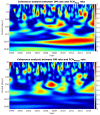Towards Understanding the Interconnection between Celestial Pole Motion and Earth's Magnetic Field Using Space Geodetic Techniques
- PMID: 34833631
- PMCID: PMC8621431
- DOI: 10.3390/s21227555
Towards Understanding the Interconnection between Celestial Pole Motion and Earth's Magnetic Field Using Space Geodetic Techniques
Abstract
The understanding of forced temporal variations in celestial pole motion (CPM) could bring us significantly closer to meeting the accuracy goals pursued by the Global Geodetic Observing System (GGOS) of the International Association of Geodesy (IAG), i.e., 1 mm accuracy and 0.1 mm/year stability on global scales in terms of the Earth orientation parameters. Besides astronomical forcing, CPM excitation depends on the processes in the fluid core and the core-mantle boundary. The same processes are responsible for the variations in the geomagnetic field (GMF). Several investigations were conducted during the last decade to find a possible interconnection of GMF changes with the length of day (LOD) variations. However, less attention was paid to the interdependence of the GMF changes and the CPM variations. This study uses the celestial pole offsets (CPO) time series obtained from very long baseline interferometry (VLBI) observations and data such as spherical harmonic coefficients, geomagnetic jerk, and magnetic field dipole moment from a state-of-the-art geomagnetic field model to explore the correlation between them. In this study, we use wavelet coherence analysis to compute the correspondence between the two non-stationary time series in the time-frequency domain. Our preliminary results reveal interesting common features in the CPM and GMF variations, which show the potential to improve the understanding of the GMF's contribution to the Earth's rotation. Special attention is given to the corresponding signal between FCN and GMF and potential time lags between geomagnetic jerks and rotational variations.
Keywords: VLBI; celestial pole offset; geomagnetic field.
Conflict of interest statement
The authors declare no conflict of interest.
Figures









References
-
- Barnes R., Hide R., White A., Wilson C. Atmospheric angular momentum fluctuations, length-of-day changes and polar motion. Proc. R. Soc. London Math. Phys. Sci. 1983;387:31–73.
-
- Salstein D. Monitoring atmospheric winds and pressures for Earth orientation studies. Adv. Space Res. 1993;13:175–184. doi: 10.1016/0273-1177(93)90220-6. - DOI
-
- Seitz F., Schuh H. Sciences of Geodesy-I. Springer; Berlin, Germany: 2010. Earth rotation; pp. 185–227.
-
- Capitaine N., Wallace P.T., Chapront J. Expressions for IAU 2000 precession quantities. Astron. Astrophys. 2003;412:567–586. doi: 10.1051/0004-6361:20031539. - DOI
-
- Capitaine N., Wallace P.T., Chapront J. Improvement of the IAU 2000 precession model. Astron. Astrophys. 2005;432:355–367. doi: 10.1051/0004-6361:20041908. - DOI
Grants and funding
LinkOut - more resources
Full Text Sources

